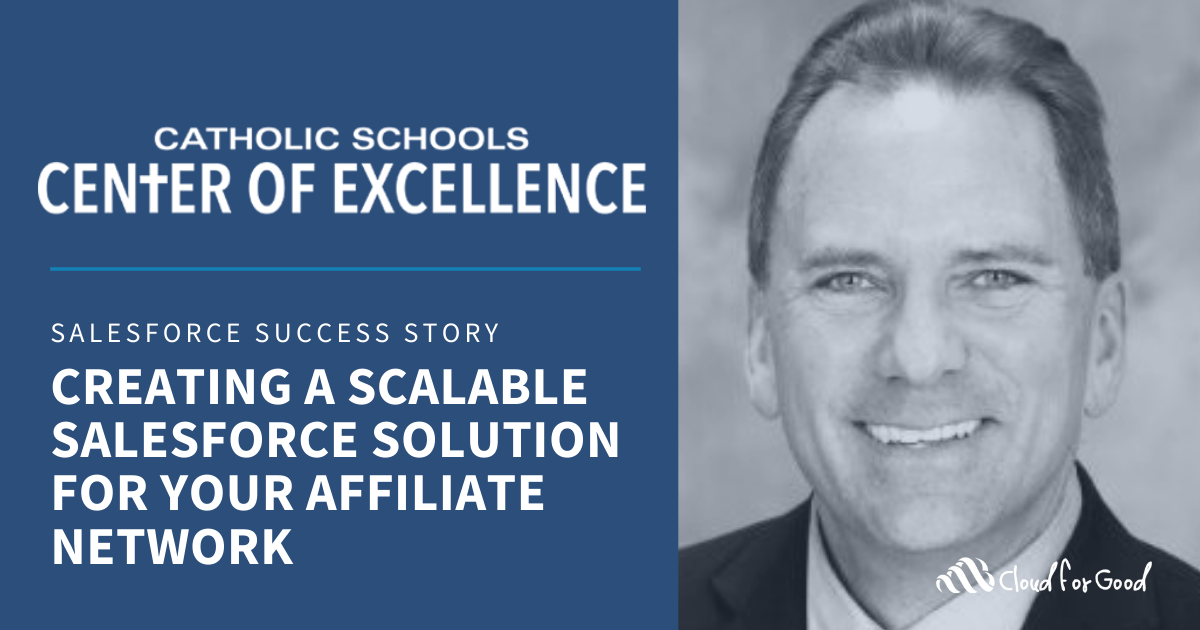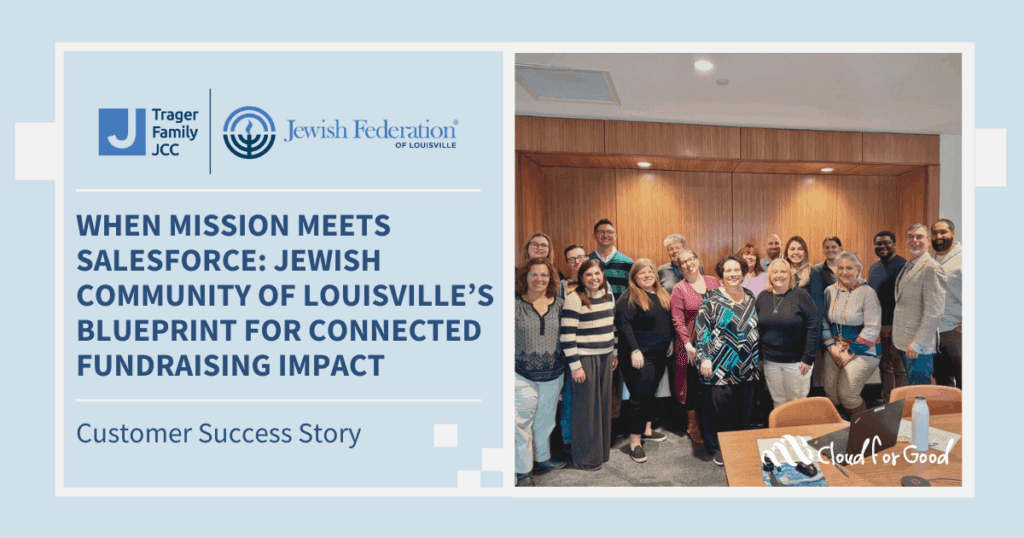Creating a Scalable Salesforce Solution for Your Affiliate Network
The Client
The Catholic Schools Center of Excellence (CSCOE) is a nonprofit organization with a simple two-part mission: to help Catholic elementary schools achieve and maintain excellence while increasing student enrollment. Their approach is to share innovative ideas, sound business practices, proven strategies and financial resources to help meet each school’s specific business and academic needs. CSCOE believes that this approach will help their schools become self-sustaining for years into the future.
Challenges
The Catholic Schools Center of Excellence is an organization that supports over 79 pre-kindergarten through 8th-grade Catholic schools in the greater Twin Cities metropolitan area of Minneapolis and St. Paul.
Needed Better Fundraising and Alumni Management
CSCOE was looking for a way to help their affiliate network schools identify, communicate with and build meaningful relationships with their key constituents; while at the same time spending less time being bogged down by manual processes for fundraising and alumni management.
Each of the schools had their own way of managing programs, often consisting of several Excel spreadsheets and manual manipulation every time a change was needed. Reporting on the success of their fundraising efforts or alumni engagement was almost impossible. While some schools took this Excel spreadsheet approach, others were managing their engagement on ad-hoc systems.
Managing the Large-Scale Technology Change
Implementing Salesforce (and training the users on how to manage their systems) across 60+ schools meant finding a solution that worked for schools with different developmental resources and familiarity with Constituent Relationship Management (CRM) tools. Managing this change brought a new set of questions to the CSCOE team: How do you implement a solution across so many affiliates? How do you address business processes that technology can’t fix? How can you take the opportunity to improve not only fundraising and alumni management but also data quality and the user experience?
The Solution
Implemented the Salesforce.org Nonprofit Cloud
To help answer these questions, CSCOE selected Salesforce as the best tool to manage each of the affiliate school’s fundraising and alumni programs, and Cloud for Good as the implementation partner to help them understand the best practices of using the Salesforce platform and manage their change. They decided to go with the Salesforce.org Nonprofit Cloud and specifically with the Nonprofit Success Pack (NPSP) data model. Because CSCOE knew they wanted to make a big impact on their schools, quickly, they chose a solution that gave each of the CSCOE affiliate schools equal footing with the management of their fundraising and alumni.
Beginning with a pilot phase, the Cloud for Good team coordinated with 10 of the affiliate schools to create a simple solution that met the needs of most of the schools within the CSCOE network.
The goal was to build a scalable Salesforce solution for fundraising and Alumni management and then deploy a new instance for each of the affiliated schools. The solution needed to be simple enough to meet the member school’s collective needs, but also customizable so that the language and picklist field values made sense for each individual school.
To fulfill this goal, Cloud for Good created an unmanaged package or a vehicle for distributing custom functionality between Salesforce organizations. The CSCOE unmanaged package consisted of custom fields, custom reports, automation, page layouts, and Lightning Pages created specifically to support the needs of the affiliate schools in fundraising and alumni management.
Having received feedback from the pilot schools, Cloud for Good made optimizations to the Nonprofit Cloud and deployed this unmanaged package to the affiliate schools over the next few months. This type of unmanaged package was perfect for CSCOE because it allowed each school to start on equal footing with the same Salesforce instance. This allowed for efficient training of multiple schools, easier support of the schools by CSCOE, and even for the schools to help each other with the learning curve. It also allowed for Cloud for Good to upload the package into the AppExchange, ready for use the next time a school within the CSCOE network is looking to implement Salesforce.
“We needed a consultant who knew the CSCOE educator audience. Someone who could speak to them as peers and know the best way to encourage user adoption and training” said Mike Halloran, Vice President of Development and Operations, Catholic Schools Center of Excellence.
Basic customization
Because the Salesforce setup was created to be scalable, it was important to train users on how to do basic customizations for terminology and custom fields that made sense to their organizations.
“I have been creating fields, reports, entering households and donations and importing households and donations. The more comfortable I get with things the more I like Salesforce,” said Doug Lieser, an early adaptor from the pilot school program.
For example, each of the schools were given the tools they needed to empower them to customize which parish their donors and alumni belong to. This type of small, but impactful customization helps the schools pull reports based the terminology and fields that resonate with each organization. Schools were taught how to handle their own additional customizations during the training phase, so as their institutions grow their Salesforce can grow with them, supporting their unique needs.
Large-scale training
“The Cloud for Good consultant we worked with has many years of experience in the education system. They knew our goals and the best practices when it came to getting our network engaged and trained,” said Halloran.
Recorded and ready when the unmanaged package was deployed, the member schools were encouraged to watch the 19 topical video tutorials that were posted to the CSCOE Vimeo account. For easy access, these videos were linked directly to the homepage of every Salesforce instance.
Users were then broken up into smaller groups to encourage greater participation. The groups were each given the opportunity to attend three, hour-long training sessions and a 30-minute office hour session to answer any lingering questions.
Case Management System
The solution was not only deployed to the CSCOE affiliate network but also directly to CSCOE itself. Cloud for Good built out a case management system in Salesforce to help them manage all feedback, issues, questions from their affiliate network.
When an email is sent to a specific CSCOE email address, Salesforce automatically creates a case. This Email-to-Case functionality pulls in and auto-populates certain case fields from the content of each email. CSCOE is then able to track and report on the feedback they are getting from their affiliate network.
Dedicated Support
CSCOE has opted to be the front line of defense when it comes to their network’s Salesforce questions, aiming to build capacity within their own structure. They have created a central hub for ongoing support, where one person supports the schools throughout their Salesforce journey.
When a question arises that CSCOE needs a bit more assistance with, there is an ability to escalate the question to Cloud for Good. This ongoing, proactive support helps give CSCOE the attention they need to set each of their affiliate schools up for success.
Results
User Adoption and Engagement
Over 70% of the CSCOE affiliate schools accepted the gift of Salesforce and took part in the deployment. Over the three-month training period, the 19-series video tutorials that Cloud for Good created have over 1,000 plays collectively. Even more impressive, 100% of schools who deployed Salesforce had at least one user attend training, while some schools had over 5 people attend.
“The engagements and participation Cloud for Good was able to help CSCOE achieve is impressive,” said Halloran. “We were able to impact these schools before the new school year.”
Positive User Experience
“Cloud for Good was able to stay incredibly organized when working with so many schools. They were very clear on their expectations and sent out meeting invitations early and met every deadline we set,” said Halloran.
It is this organization that made the transition from the school’s unique systems (whether manual or electronic) to Salesforce seamless. From implementation to user training all the way to reminders for the registration of their Salesforce licenses, the Cloud for Good team was with the CSCOE network every step of the way.





